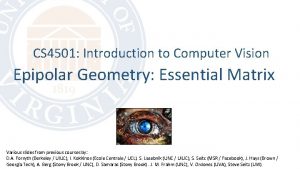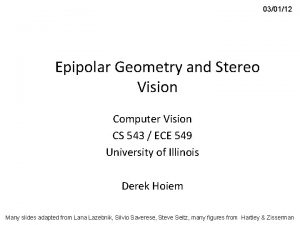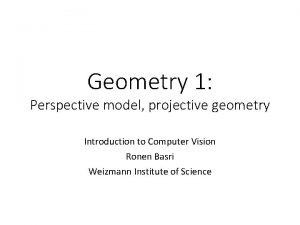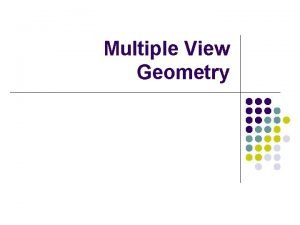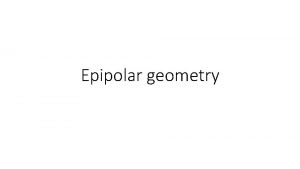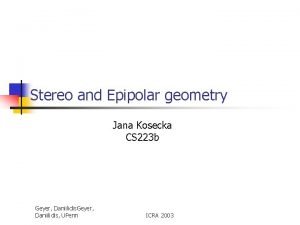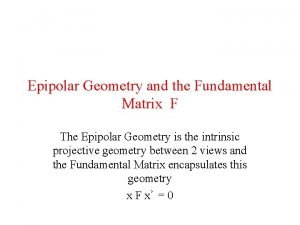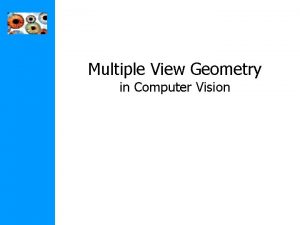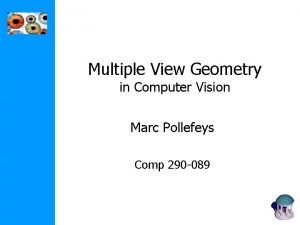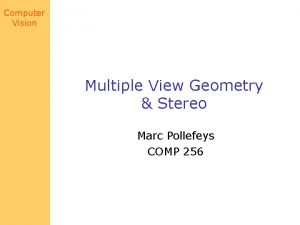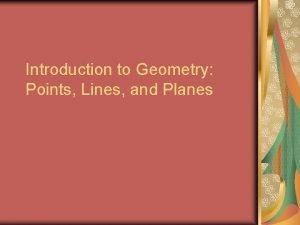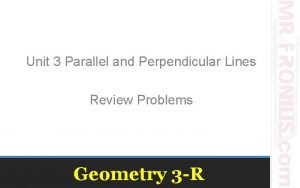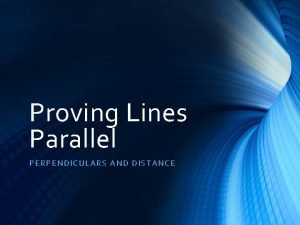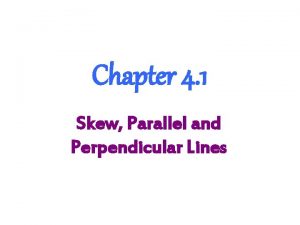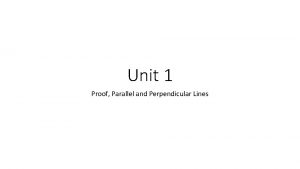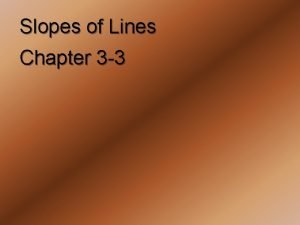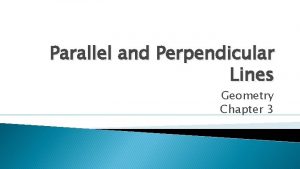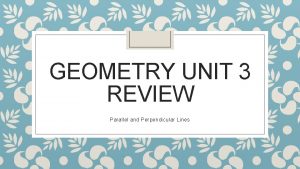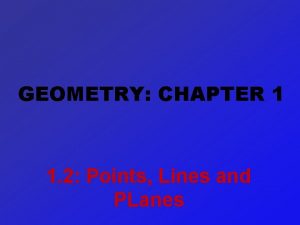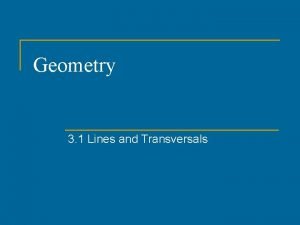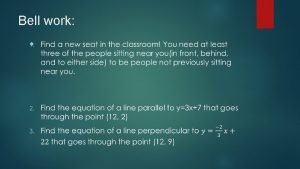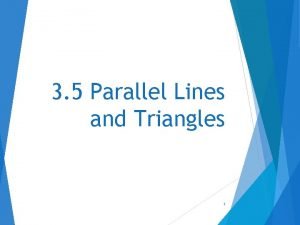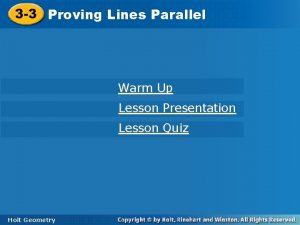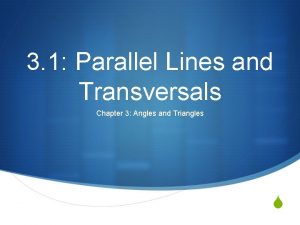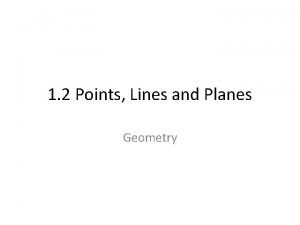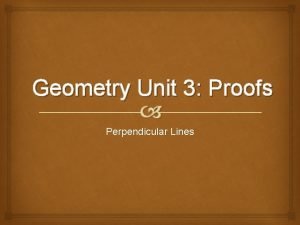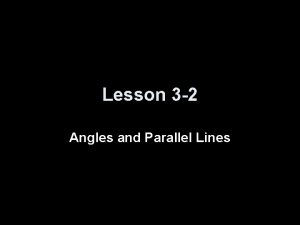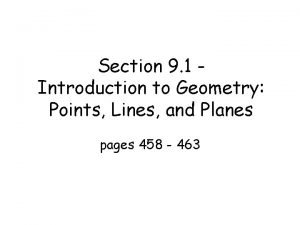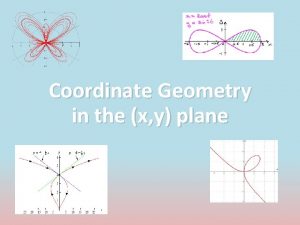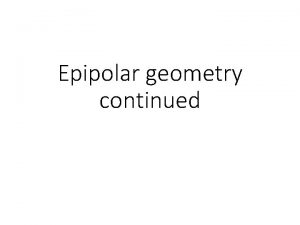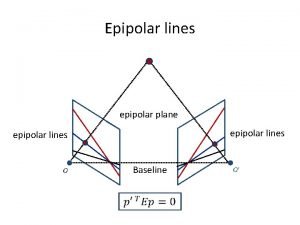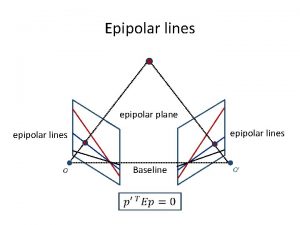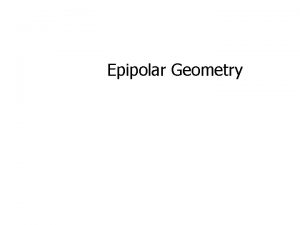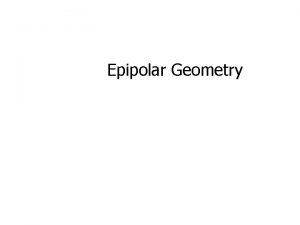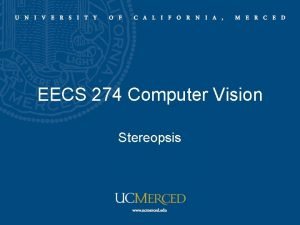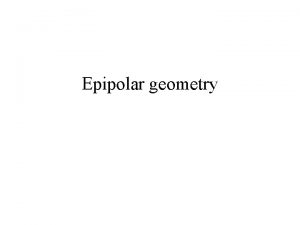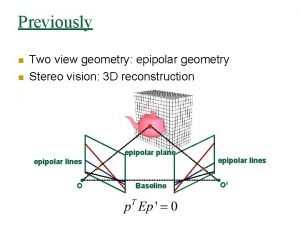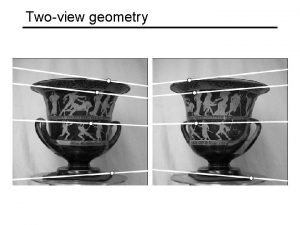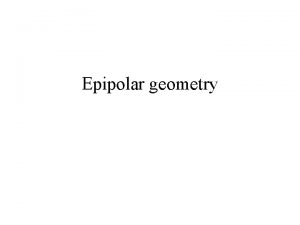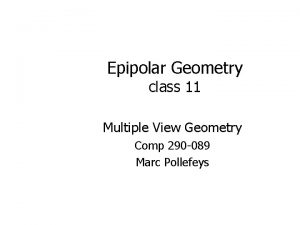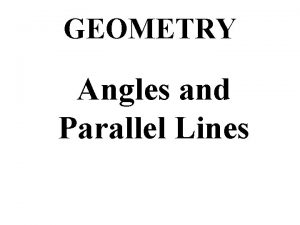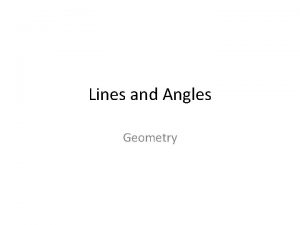Geometry 2 Epipolar Lines Introduction to Computer Vision







































- Slides: 39

Geometry 2: Epipolar Lines Introduction to Computer Vision Ronen Basri Weizmann Institute of Science

Material covered • Pinhole camera model, perspective projection • A taste of projective geometry • Homography (planes, camera rotation) • Two view geometry, general case: • Epipolar geometry, the essential matrix • Camera calibration, the fundamental matrix • Stereo vision • 3 D reconstruction from two views • Multi-view geometry, reconstruction through factorization

Hierarchy of transformations Rigid Preserves angles, lengths, area, parallelism Similarity Preserves angles, parallelism Affine Preserves parallelism Homography Preserves cross ratio

Camera rotation •

Planar scene •

Camera matrix •

Calibration matrix •

Two view geometry epipolar line

Epipolar plane Definition: Epipolar plane: a plane that contains the baseline epipolar plane Baseline epipolar line

Epipoles • • • Each epipolar plane produces a pair of epipolar lines There is a 1 -D system of epipolar planes All epipolar planes contain the baseline All epipolar lines intersect at the epipole An epipole is the projection of the right focal center onto the left image (and vice versa) epipolar lines Baseline


Epipolar constraints: the essential matrix • Epipolar plane Baseline

Cross product, triple product •

Epipolar constraints: the Essential matrix •


Uncalibrated case: the Fundamental matrix •


Summary Homography Perspective (calibrated) Perspective (uncalibrated) Orthographic One-to-one (group) Concentric epipolar lines Parallel epipolar lines Form Properties DOFs 8(5) 8(7) 4 Eqs/pnt 2 1 1 1 Minimal configuration 4 5+ (8, linear) 7+ (8, linear) 4 Depth No Yes, up to scale Yes, projective Affine structure (third view required for Euclidean structure)

Recovering epipolar constraints

Recovering epipolar constraints: pipeline •

SIFT matches

Epipolar lines

Rectification • Homography to make epipolar lines horizontal Baseline O O’

Rectification Baseline O O’

Disparity •

The correspondence problem • Stereo matching is ill-posed: • Matching ambiguity: different regions may look similar

The correspondence problem • Stereo matching is ill-posed: • Matching ambiguity: different regions may look similar • Specular reflectance: multiple depth values

Random dot stereogram • Depth is perceived from a pair of random dot images • Stereo perception is based solely on local information (low level)

Moving random dots

Dynamic programming • Each pair of epipolar lines is compared independently • Local cost, sum of unary term and binary term • Unary term: cost of a single match • Binary term: cost of change of disparity (occlusion) • Analogous to string matching (‘diff’ in Unix)

String matching • Swing → String S t r i n g Start S w i n g End

String matching • Cost: #substitutions + #insertions + #deletions S t r i n g S w i n g


Stereo with dynamic programming • Shortest path in a grid • Diagonals: constant disparity • Moving along the diagonal – pay unary cost (cost of pixel match) • Move sideways – pay binary cost, i. e. disparity change (occlusion, right or left) • Cost prefers fronto-parallel planes. Penalty is paid for tilted planes

Dynamic programming on a grid Start

Dynamic programming: pros and cons • Advantages: • Simple, efficient • Achieves global optimum • Generally works well

Dynamic programming: pros and cons • Advantages: • Simple, efficient • Achieves global optimum • Generally works well • Disadvantages: • Works separately on each epipolar line, does not enforce smoothness across epipolars • Prefers fronto-parallel planes • Too local? (considers only immediate neighbors)

Probability interpretation: the Viterbi algorithm •

Probability interpretation: the Viterbi algorithm •
 Epipolar geometry computer vision
Epipolar geometry computer vision Epipolar geometry computer vision
Epipolar geometry computer vision Epipolar geometry tutorial
Epipolar geometry tutorial Epipolar geometry
Epipolar geometry Um in m
Um in m Epipole
Epipole Geometry
Geometry Essential matrix
Essential matrix Multiple view geometry in computer vision pdf
Multiple view geometry in computer vision pdf Quadrifocal
Quadrifocal Multiple view geometry in computer vision
Multiple view geometry in computer vision Cs766
Cs766 Introduction to geometry points lines and planes
Introduction to geometry points lines and planes Lewis dot structure and molecular geometry
Lewis dot structure and molecular geometry Electron domain geometry vs molecular geometry
Electron domain geometry vs molecular geometry Covalent bond order
Covalent bond order Unit 3 parallel and perpendicular lines
Unit 3 parallel and perpendicular lines Proving lines parallel
Proving lines parallel Skew lines definition geometry
Skew lines definition geometry Honors geometry parallel lines and transversals worksheet
Honors geometry parallel lines and transversals worksheet Geometry unit 1 proof parallel and perpendicular lines
Geometry unit 1 proof parallel and perpendicular lines 3-3 slopes of lines
3-3 slopes of lines Unit 3 parallel and perpendicular lines quiz 3-2
Unit 3 parallel and perpendicular lines quiz 3-2 Geometry chapter 3 review parallel and perpendicular lines
Geometry chapter 3 review parallel and perpendicular lines Lesson 1-2 geometric figures
Lesson 1-2 geometric figures Geometry 1-2 points lines and planes
Geometry 1-2 points lines and planes Geometry 3-1 parallel lines and transversals
Geometry 3-1 parallel lines and transversals Geometry 3-5 parallel lines and triangles
Geometry 3-5 parallel lines and triangles 3-5 parallel lines and triangles
3-5 parallel lines and triangles 3-5 proving lines parallel answers
3-5 proving lines parallel answers 3-1 parallel lines and transversals
3-1 parallel lines and transversals 1-2 points lines and planes answer key geometry
1-2 points lines and planes answer key geometry Name the intersection of line qz and segment wu
Name the intersection of line qz and segment wu Adjacent vs perpendicular
Adjacent vs perpendicular Lesson 7-1 parallel lines and angle relationships
Lesson 7-1 parallel lines and angle relationships Geometry in computer graphics
Geometry in computer graphics Section 1 introduction to geometry answers
Section 1 introduction to geometry answers Coordinate geometry in the (x y) plane
Coordinate geometry in the (x y) plane 16-385 computer vision
16-385 computer vision Kalman filter computer vision
Kalman filter computer vision
